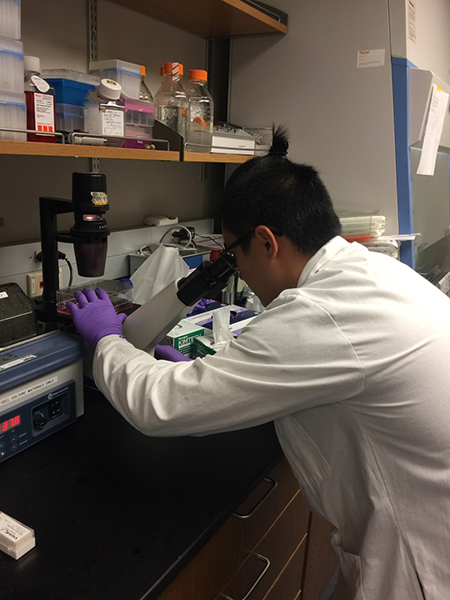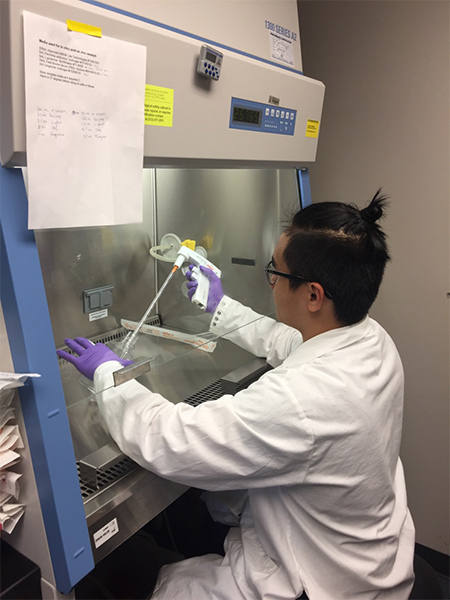Alex Khang graduated in 2016 with an honors degree in biomedical engineering from the University of Arkansas. He is presently a PhD student in biomedical engineering at the University of Texas at Austin, and was recently awarded a National Science Foundation Graduate Research Fellowship for the upcoming academic year.
UArk BME: When you first arrived at the U of A, did you know what you wanted to study?
Khang: I did not know exactly what I wanted to study but I knew that math and science were my strongest areas so I considered majoring in an engineering discipline. Biomedical Engineering stood out to me amongst the rest of the engineering majors at the University of Arkansas due to its dedication to bettering the state of human health.
UArk BME: With regard to work you’ve done at the U of A, what was it like working in the lab under Dr. Balachandran?
Khang: I want to start out by saying Dr. Balachandran was a fantastic mentor, and that he had a very large impact on my decision to pursue graduate school. Dr. Balachandran was very helpful during the NSF application process not only for me but for current and past lab members as well (Nasya Sturdivant—awarded NSF 2014; Stephanie Cone—awarded NSF 2016). Working in his lab was a tremendous experience. In the Mechanobiology and Soft Materials Laboratory (MSML), I learned a lot about how to conduct biomedical research and specifically a lot about nanofiber fabrication. Under Dr. Balachandran’s tutelage I got the chance to travel to national and international conferences to present our research and meet other members of the biomedical science community. Most importantly, I formed friendships in that lab that are irreplaceable.
UArk BME: While at the U of A, you coauthored an article and presented a conference poster on Janus-type polymer protein nanofibers. What’s the value of publishing research like this as an undergrad?
Khang: The value is enormous. Scientifically, it is a great feeling to contribute to your field of interest in the form of new techniques and/or knowledge. It is every researcher’s goal (or it should be) to contribute to science in a positive manner and to help translate science to benefit society as a whole.
As far as personal value goes, few undergraduates have the opportunity to publish papers in general and doing so really gives your applications a boost whether it be for graduate school, medical school, and/or fellowships. Publications and presentations are very beneficial accomplishments that stick with you forever.
UArk BME: You’re now pursuing a doctorate in biomedical engineering at the University of Texas at Austin. What made you decide to pursue a PhD as opposed to going into industry?
Khang: For a long time I knew that I didn’t want to stop at a bachelor’s degree. I aspire to go into academia and a PhD is a common prerequisite for that. I think that the creative freedom and the freedom to pursue your own ideas really attracted me to academia as opposed to industry.
UArk BME: How is being a grad student (in terms of your schoolwork, or your life more generally) different from being an undergrad? Is there anything that’s surprised you?
Khang: In my experience, being a graduate student is very different from being an undergraduate student. The bulk of your focus in on your research project rather than your coursework. The level of difficulty with balancing obligations is more or less the same at the graduate level. The major difference is perhaps the tremendous amount of responsibility you have as a graduate student. That’s probably the only surprising aspect of graduate school.
UArk BME: What was the application process for the NSF Fellowship like? What was the most challenging part of the process for you?
Khang: The application process for the NSF Fellowship is rather short compared to other fellowships. The main components consist of a three page Personal, Relevant Background, and Future Goals Statement and a two page Graduate Research Plan Statement. Three letters of recommendation are also required. The most challenging part for me was the Research Statement. As a first year graduate student, it is hard to define what, exactly, you want to work on for your dissertation. In my situation specifically, I had only been a part of the UT-Austin BME department for 2 months before submitting my application and it was difficult putting together a quality research plan in that short period of time.
UArk BME: How did you react when you found out you’d won the Fellowship?
Khang: The first thing I do when I wake up in the morning is check my email so I found out first thing in the morning that I had been awarded the fellowship. I was very, very happy but more relieved that I didn’t have to apply for any more fellowships in the near future. I spent a good amount of that morning thanking the people who helped me during the application process.
UArk BME: Can you describe in detail the research you’ll be doing with the NSF Fellowship?
Khang: I proposed to investigate the mechanobiology of valve interstitial cells (VICs) using a 3-D poly(ethylene glycol) gel. Synthetic gels succeed where 2-D substrates and naturally occurring tissues are limited specifically in the realms of tunable mechanics and tunable adhesion availability. With synthetic gels we can modulate the 3-D microenvironment and study the resulting biomechanical and biosynthetic response of VICs through micromechanical testing and bioreactor studies. In the future, computational models will be developed to describe and possibly predict the biomechanical behavior of VICs in these dynamic environments.
UArk BME: Any advice for other UArk students looking to apply for awards/fellowships?
Khang: APPLY FOR THE NSF YOUR SENIOR YEAR. As most people may know the rules have changed recently for the NSF GRFP and graduate students can only apply once. It is to your benefit to apply your senior year of college to give yourself a second chance when in graduate school if you do not get it the first time around. Aside from that, be very careful in choosing who you ask to provide a letter of recommendation. Try to choose people you have a longstanding professional relationship with, and people who can speak to your abilities with integrity.
UArk BME: A biomedical engineer learns he/she is going to be stranded on a deserted island, and will be allowed to bring only three items with her. What does she bring?
Khang: She should probably bring a copy of the movie Cast Away starring Tom Hanks, a portable DVD player (fully charged) to watch it on, and a Volleyball (preferably Wilson brand) for companionship.




